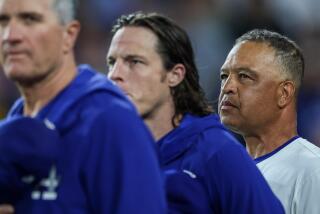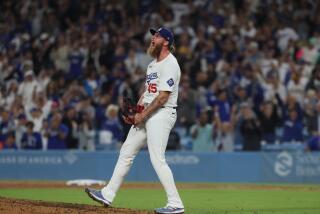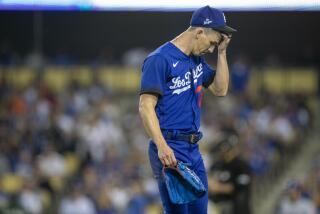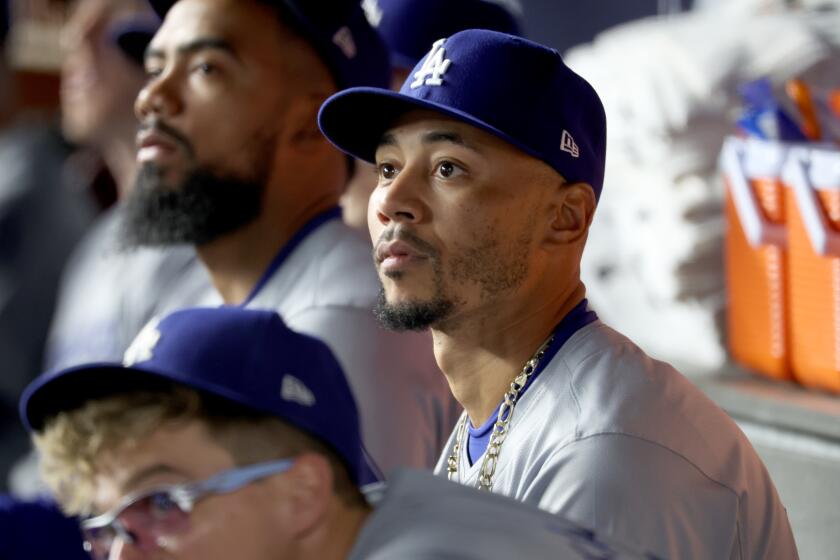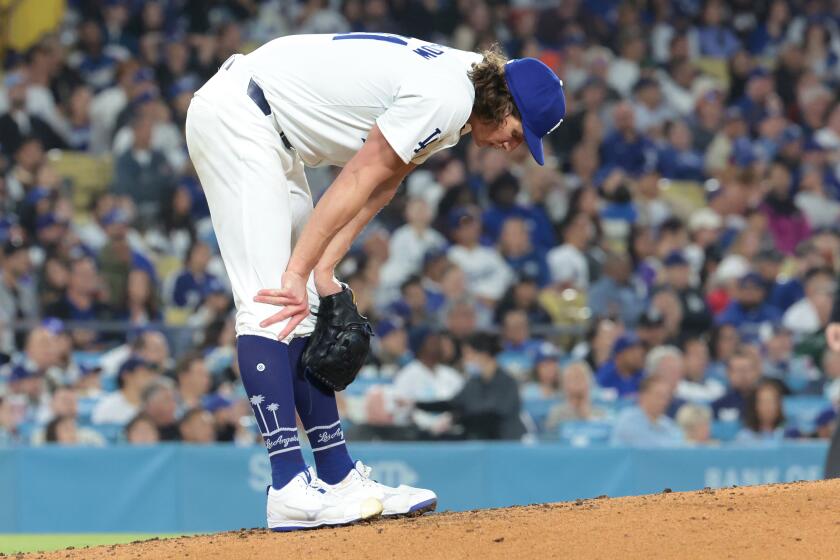Dodgers trying to keep up with pace-of-play changes
Reporting from PHOENIX — By now, as he enters his 19th season in professional baseball, Dodgers veteran Chase Utley operates by instinct. At certain moments in a game, he can sense when his presence is required on the mound. He will leave his post at second base, trot toward the pitcher and offer some insight.
Before 2018, Utley’s visits to the mound counted only toward his intrinsic value to the Dodgers, who re-signed the 39-year-old to a two-year contract this offseason. Now those visits will be cataloged on the scoreboard, part of Major League Baseball’s implementation of a mound-visit restriction for this season.
“I’ve always felt like having the ability to slow the game down in certain situations for the betterment of play is important,” Utley said. “There will still be some opportunities to do that. Just not quite as many.”
Utley’s impulse to momentarily decelerate the game’s pace to help his team win a game contradicts the apparent mandate of Commissioner Rob Manfred, who has made speeding up the sport a crucial part of his tenure since taking over in 2015.
Manfred has announced a six-visit cap on mound visits for the 2018 season. The league did not implement a pitch clock, which pleased players, but the labor force has still expressed discontent with the interference with the sport’s natural order. Spring-training games will provide umpires and teams a chance to see the rules in action.
After Friday’s Cactus League opener, Dodgers manager Dave Roberts met with Joe Torre, the former Dodgers manager and now MLB’s vice president for baseball operations. Torre tried to explain some of the standards that umpires will enforce in 2018. The Dodgers expect to receive video from the commissioner’s office outlining what constitutes a mound visit, and what does not.
“Right now, we’re still working through it,” Roberts said.
Roberts can conjure plenty of scenarios that fall into a gray area: What if a third baseman approaches the center of the diamond to offer advice on a bunting batter? What if the first baseman confers with the pitcher after they meet near the bag on a ground ball? The variations feel endless.
Utley intends to adjust to the rules. He is unsure how he will handle his instincts under the new parameters. He expected the level of communication between innings to increase, but he stressed that certain situations on the field require conversation, too.
“It’ll be interesting how it plays out,” Utley said. “It’s probably going to take a little bit of time for everyone to get used to. I understand the reasoning behind it. I’m just hoping it doesn’t affect the quality of play.”
Farmer loosens up behind the plate
For catcher Kyle Farmer, two teammates block a path to the majors. The Dodgers already employ Yasmani Grandal and Austin Barnes, who were one of the most valuable catching duos in baseball in 2017, and Farmer resides third on the depth chart. He aided the team in the second half and appeared in the postseason as an ancillary component, most notable because his presence allowed the Dodgers to use Grandal or Barnes as a pinch-hitter.
Farmer sought to create a more prominent role for himself in 2018. In addition to taking ground balls at third base, he engaged in a series of exercises in the offseason designed to improve the flexibility of his hips and the fluidity of his receiving. He took Pilates classes and completed exercises sent by strength and conditioning coach Brandon McDaniel.
“His hips were really tight,” Roberts said. “And so he couldn’t squat. As he tried to get into that squatting position, it was more of a stab at the low ball. Now he can work underneath the baseball. Now his hips are more naturally down lower.”
The Dodgers are expected to carry a four-man bench to start the season. One catcher will already occupy a spot. With Enrique Hernandez, Chase Utley and Matt Kemp in the mix, Farmer appears bound for a regular spot catching with triple-A Oklahoma City.
At least, until the Dodgers require him at the major league level.
“He adds value in so many different ways,” Roberts said. “And his ability to conduct an at-bat off the bench, that’s hard to do. That opens up opportunities for the other two catchers, and he can defend at third base.”
Twitter: @McCulloughTimes
More to Read
Are you a true-blue fan?
Get our Dodgers Dugout newsletter for insights, news and much more.
You may occasionally receive promotional content from the Los Angeles Times.
